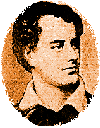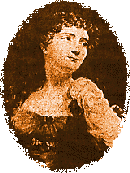
![]()
 Charles Babbage (1792-1871) - English mathematician and mechanician,
made a fellow of the Royal Society in 1816. Early interested in
the harm to scientific endeavors caused by errors in calculation
of tables. In 1822, discussed with the Royal Society the principles
of a calculating machine, to the construction of which he devoted
many years of his life. From 1828 to 1839, Lucasian professor
of mathematics at Cambridge. During the later years of his life
he resided in London, devoting himself to the construction of
his mathematical machines.
Charles Babbage (1792-1871) - English mathematician and mechanician,
made a fellow of the Royal Society in 1816. Early interested in
the harm to scientific endeavors caused by errors in calculation
of tables. In 1822, discussed with the Royal Society the principles
of a calculating machine, to the construction of which he devoted
many years of his life. From 1828 to 1839, Lucasian professor
of mathematics at Cambridge. During the later years of his life
he resided in London, devoting himself to the construction of
his mathematical machines.
![]()
![]() A brief Babbage biography
A brief Babbage biography
![]()
![]() The Babbage Pages
The Babbage Pages
Baize - A coarse woolen cloth with a long nap, commonly dyed green or red and chiefly used for curtains and linings.
Ballester-Mollina - .45 caliber ACP automatic pistol, modified copy of the Colt .45 caliber M1911A1, made in Argentina by the firm of Hafdasa. Large numbers were made during WWII.
Alphonse Bertillon (1853-1914) - French anthropologist, son of
Louis Bertillon. Best known for the science of anthropometry and the Bertillon system of identification, introduced in 1882, in
which an individual (such as a criminal or other subject of official
interest) is identified by means of body measurements, peculiar
markings such as scars, and personality characteristics. He was
a witness for the prosecution in the Dreyfus case in 1899. After
the turn of the century, his system of identification was superceded
by the use of fingerprints.
![]()
![]() Photo of Bertillon
Photo of Bertillon
![]()
![]() Bertillon's System
Bertillon's System
![]()
![]() Taking Bertillon Measurements
Taking Bertillon Measurements
![]()
![]() Bertillon's Eye Chart and Hannibal Lector
Bertillon's Eye Chart and Hannibal Lector
Jacques Bertillon (1851-1922) - French statistician, son of Louis
Bertillon and author of La Statistique humaine en France
(1880).
![]()
![]() Jacques Bertillon and the history of disease classification
Jacques Bertillon and the history of disease classification
Louis Adolphe Bertillon (1812-1883) - French statistician, appointed professor of demography at the school of anthropology in Paris, 1876. Author of Demographie figuree de la France (1874).
Sir Henry Bessemer (1813-1898) - English engineer and inventor,
chiefly known for his connection with the Bessemer process for
the inexpensive manufacture of steel, a problem in which he became
interested while attempting to improve the construction of guns.
Although he outlined the process before the British Association
in 1856, it took more than a decade to perfect, and was never
widely adopted in Britain because of the quality of British iron,
which was better suited to the open-hearth process. The latter
method, established in 1879, became the method of choice in Britain.
The Bessemer method was widely employed after 1878 in Europe and
the United States.
![]()
![]() Sir Henry's autobiography
Sir Henry's autobiography
William Blake (1757-1827) - Visionary poet, artist, engraver,
and printer. During his life, neither his poetry nor his art found
a wide audience, and he passed his last years in relative obscurity.
His reputation began to grow after publication of a biography
in 1863.
![]()
![]() The William Blake Archive
The William Blake Archive
 Bone Wars - In the late 19th century, an extraordinarily bitter
rivalry developed between two eminent American paleontologists,
Othniel C. Marsh and Edward Drinker Cope. Marsh, discoverer of
the brontosaurus, rushed his description of it into print to beat
Cope, describing the animal from a headless skeleton found in
1879. In his haste, he reconstructed a small head from two unrelated
skulls found miles from the site. In 1900, Henry Osborn, in assembling
his own headless brontosaurus at the American Museum of Natural
History in New York, used a cast of the Marsh skull. In 1915,
Earl Douglass at the Carnegie Museum discovered a brontosaurus
with a likely but larger and elongated skull, and suggested in
print that Osborn may have mounted the wrong head. Osborn, described
as "a man who could (and did) destroy the scientific reputations
of those who opposed him," then dared Douglass to mount the
skull. The Carnegie brontosaurus stayed headless until 1932, when
Douglass died and a model of the smaller head was mounted. In
1975, with convincing evidence that the larger skull was correct,
Carnegie and most other museums replaced the Marsh skull with
the Douglass. The AMNH for ninety years had a tiny skull
on its brontosaurus, though it may have lost its head in the recent (1999) remodeling. The ghost of Osborne rules the AMNH website, however: the images of brontosauruses (more properly called apatosauruses) shown there all have small heads.
Bone Wars - In the late 19th century, an extraordinarily bitter
rivalry developed between two eminent American paleontologists,
Othniel C. Marsh and Edward Drinker Cope. Marsh, discoverer of
the brontosaurus, rushed his description of it into print to beat
Cope, describing the animal from a headless skeleton found in
1879. In his haste, he reconstructed a small head from two unrelated
skulls found miles from the site. In 1900, Henry Osborn, in assembling
his own headless brontosaurus at the American Museum of Natural
History in New York, used a cast of the Marsh skull. In 1915,
Earl Douglass at the Carnegie Museum discovered a brontosaurus
with a likely but larger and elongated skull, and suggested in
print that Osborn may have mounted the wrong head. Osborn, described
as "a man who could (and did) destroy the scientific reputations
of those who opposed him," then dared Douglass to mount the
skull. The Carnegie brontosaurus stayed headless until 1932, when
Douglass died and a model of the smaller head was mounted. In
1975, with convincing evidence that the larger skull was correct,
Carnegie and most other museums replaced the Marsh skull with
the Douglass. The AMNH for ninety years had a tiny skull
on its brontosaurus, though it may have lost its head in the recent (1999) remodeling. The ghost of Osborne rules the AMNH website, however: the images of brontosauruses (more properly called apatosauruses) shown there all have small heads.
![]()
![]() Another skull story
Another skull story
![]()
![]() Visit the quarry at Dinosaur National Monument
Visit the quarry at Dinosaur National Monument
![]()
![]() See tiny-headed bronotsaurs at the American Museum of Natural History There's another small-headed brontosaurus/apatosaurus in the Hall of the Saurischian Dinosaurs.
See tiny-headed bronotsaurs at the American Museum of Natural History There's another small-headed brontosaurus/apatosaurus in the Hall of the Saurischian Dinosaurs.
![]()
![]() More about Othniel.C. Marsh
More about Othniel.C. Marsh
![]()
![]() Edward Cope, a neo-Lamarkian
Edward Cope, a neo-Lamarkian
![]()
![]() About Earl Douglass
About Earl Douglass
Brontosaurus - See Apatosaurus.
Brotherhood of the New Life - A Utopian religious organization
founded by Thomas Lake Harris. Because of Laurence Oliphant's influence, some twenty Japanese entered the brotherhood. These included:
![]() Hatakeyama Yoshinari (1843-1876), later president of Tokyo Kansei Gakko.
Hatakeyama Yoshinari (1843-1876), later president of Tokyo Kansei Gakko.
![]() Ichiki Kanjuro - commonly known as Mitsumura Junzo (1842-1919), later an admiral in the Japanese navy.
Ichiki Kanjuro - commonly known as Mitsumura Junzo (1842-1919), later an admiral in the Japanese navy.
![]() Samejima Hisanobu
(1846-80) and Yoshida Kiyonari (1845-91), both later ambassadors.
Samejima Hisanobu
(1846-80) and Yoshida Kiyonari (1845-91), both later ambassadors.
![]() Arai Osui, who transmitted Harris's ideas to Japan.
Arai Osui, who transmitted Harris's ideas to Japan.
![]() Nagasawa Kanaye (1852-1934), Harris's lieutenant and heir, who continued the brotherhood until 1934.
Nagasawa Kanaye (1852-1934), Harris's lieutenant and heir, who continued the brotherhood until 1934.
Isambard Kingdom Brunel (1806-1859) - English engineer, designer
of the first transatlantic steamer. Engineer on the Thames tunnel
project, from 1825 until 1828, when the work was stopped. Responsible
for a number of British suspension bridges, docks and piers, he
also took a leading part in the systematic development of ocean
steam navigation.
![]()
![]() Brunel bio, lots of pictures
Brunel bio, lots of pictures
William Buckland (1784-1856) - English divine and geologist, systematically examined geological structure of Great Britain. Elected president of the Geographical Society in 1824 and 1840.
Burgess Shale fauna - Multi-cellular animals of the Cambrian age,
discovered in 1909 in a quarry in British Columbia by Charles
Doolittle Walcott of the Smithsonian Institution. Walcott misinterpreted
the nature of the animals, consistently placing them in modern
invertebrate categories. They were reinterpreted in 1971 by Prof.
Harry Whittington of Cambridge University, using new investigative
techniques, in a way that cast a different light on the entire
history of life and evolution. These soft-bodied fossiles reveal
the history of life, in the words of Stephen Jay Gould, as one
of "massive removal followed by differentiation within a
few surviving stocks, not the conventional tale of steadily increasing
excellence, complexity, and diversity."
![]()
![]() A visit to the Walcott quarry
A visit to the Walcott quarry
![]()
![]() Cambrian Park
Cambrian Park
Sir Richard Francis Burton, (1821-1890) - British explorer, linguist,
and orientalist, one of the most flamboyant characters of his
day. His journey in 1853 to Mecca, forbidden to non-Muslims, made
him famous, although it was neither unique nor as dangerous as
most people imagined. He followed it with other, more dangerous
adventures in Africa and elsewhere. He is best-known now for his
unexpurgated versions The Arabian Nights, The Kama Sutra,
and The Perfumed Garden.
![]()
![]() Sir Richard in a dramatic hat
Sir Richard in a dramatic hat
 George Gordon, Lord Byron (1788-1824) - English poet,
who gave his name to a passionate, rebellious, thoroughly Romantic
way of life. As famous for his flamboyant and scandalous sexual
liaisons as for his poetry, he also held liberal political views
and expounded them in the House of Lords. In his shortlived marriage
to Lady Noel Byron, he fathered his only legitimate daughter,
Ada. Expatriate on the continent for eight years, he traveled
to Greece in 1824 to give support to the insurgency there, but
died of fever before seeing any military action.
George Gordon, Lord Byron (1788-1824) - English poet,
who gave his name to a passionate, rebellious, thoroughly Romantic
way of life. As famous for his flamboyant and scandalous sexual
liaisons as for his poetry, he also held liberal political views
and expounded them in the House of Lords. In his shortlived marriage
to Lady Noel Byron, he fathered his only legitimate daughter,
Ada. Expatriate on the continent for eight years, he traveled
to Greece in 1824 to give support to the insurgency there, but
died of fever before seeing any military action.
![]()
![]() Byron as a reader of gothic novels
Byron as a reader of gothic novels
![]()
![]() A collection of Byron's poetry
A collection of Byron's poetry
 Lady Noel Byron (1792-1860) - Born Anne Isabella (Annabella)
Millbanke, the wife of Byron and mother of his only legitimate
child, Ada. She and her husband separated before the child was
six weeks old, and Byron left England for good several months
later. Lady Byron has been described as the personification of
discord and implacability, and she seems to have spent most of
her life dominating her daughter, fortifying her own reputation
as a model of superhuman virtue, and planting juicy rumors of
her husband's sexual excesses.
Lady Noel Byron (1792-1860) - Born Anne Isabella (Annabella)
Millbanke, the wife of Byron and mother of his only legitimate
child, Ada. She and her husband separated before the child was
six weeks old, and Byron left England for good several months
later. Lady Byron has been described as the personification of
discord and implacability, and she seems to have spent most of
her life dominating her daughter, fortifying her own reputation
as a model of superhuman virtue, and planting juicy rumors of
her husband's sexual excesses.
![]()
The Difference Dictionary was first published
in slightly different form in Science Fiction Eye, Issue #8.
Text copyright 1990, 1996, 2001, 2003,
by Eileen K. Gunn.


